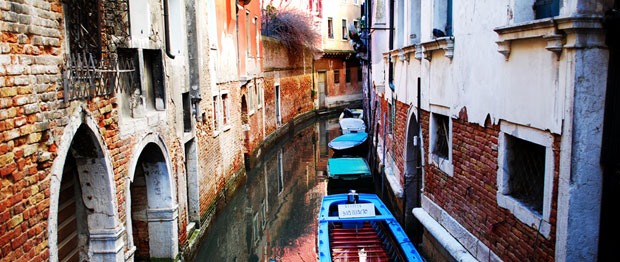Navigate Venice without a map

One of the great things about the sumptuous Italian city of Venice is that, even though it's full of winding alleys and canals, it's not always important to use a map—sometimes it's better to get lost. If you are looking to navigate Venice without a map, look no further. Cover-More has compiled the must-see sights of Venice in one handy guide.
Of course, while you're gazing in awe at St Mark's Basilica or gliding along the canals, serenaded by a gondolier, we recommend you give yourself a little time to get lost, as well.
Getting around
Venice is located in a lagoon and comprised of a number of islands. You'll spend a lot of your time wandering the alleys of the centro storico (historic centre), crossing bridges over dizzying networks of canals on the main island.
To travel between islands, you'll need to catch a vaporetto, the term for a ferry. This is usually sufficient to get you around, but if you're going well off the beaten track, you will need to find a water taxi.
Make sure you have as detailed a map as possible as well as directions to your accommodation. But as Venice's labyrinthine structure is notorious for confusing tourists, don't be afraid to ask for directions if lost. Many Italians will be able to help you in English, but bring along an Italian phrasebook so you can recite key questions, just in case.
The must-see's
St Mark's Square and Basilica are tourist hotspots, but for good reason. Be wowed by the cathedral's majestic exterior, then feel your jaw drop as you gaze inside. With lofty dome ceilings, extensive use of gold and vast mosaics, it's hard not be moved by this artistic and architectural feat.
Nearby, you can visit the equally impressive Doge's Palace, the former political centre of Venice, where the leader of the state, known as Doge, lived and worked. Now the palace serves as a museum, where you can visit old Doge's private rooms, staterooms used for cabinet meetings, criminal court and even prison facilities.
Cross the famous Bridge of Sighs that leads to the cells, where criminals were sent to serve their time.
Take some time to truly soak in the majesty of this palace, filled with awe-inspiring works of art and displays of immense wealth.
What to do on the water
Leave the tourist centre of Venice behind and head to lesser-known but equally spectacular destinations.
A trip to Murano is a must, as this is where the Venetian art of glass-blowing began. Watch demonstrations, buy stunning glasswork and explore this mystical island, steeped in lore and legend.
During the peak of Venetian glassmaking in the 14th century, glassblowers were forbidden to leave Venice in order to preserve the art and its exclusivity. Apart from this, glass blowers often enjoyed opulent lifestyles, treated well by the state as a reward for their skill.
The spooky and atmospheric San Michele, colloquially known as Cemetery Island, often draws visitors in, too. The whole island is indeed a cemetery, home to a vast number of Venetian graves. Some are beautiful marble works of art while other sections of the cemetery wallow in disrepair. Notable tombs here include those of Igor Stravinsky and Ezra Pound.
Just in case you lose your footing in an uneven alley path or manage to tumble out of a gondola, prepare for your journey to Venice with travel insurance and more tips on travelling to Italy from Cover-More New Zealand.
Headed to another Italian destination?
Take a look at a few Italy-specific travel articles you might be interested in: